Employee influence
Corporate governance at the local Rabobanks
Management and supervision of the local Rabobanks
A few years ago, the Group Works Council of Member Banks (GOR AB) was created as an
employee representative body. It acts as a discussion partner to the manager on issues that
concern the social policy of all local Rabobanks. The creation of the GOR AB does not affect
the position of Rabobank Nederland's Works Council or the existing Works Councils of the
local Rabobanks. As a result, they continue to act in full as employee representative bodies
within the meaning of the Works Councils Act.
Only banks that have a cooperative structure and whose Articles of Association have been
approved by Rabobank Nederland can be members of Rabobank Nederland. In turn, the
local Rabobanks have members as well, who are local clients. The local Rabobanks have
strictly defined rights and obligations towards Rabobank Nederland and each other.
Pursuant to the prudential supervision part of the Financial Supervision Act and under
Rabobank Nederland's Articles of Association and the Articles of Association of the local
Rabobanks, Rabobank Nederland supervises the local Rabobanks on (the integrity of their
operations, solvency and liquidity. In addition, under the conduct supervision part of the
Financial Supervision Act, Rabobank Nederland has been appointed by the Dutch Finance
Ministry as the holder of a collective license that also includes the local Rabobanks.
Thus, the supervision of conduct by the AFM is exercised through Rabobank Nederland.
Two governance models are possible for the local Rabobanks. The introduction of a second
governance model - the executive model - besides the existing partnership model was
prompted at the time by the wish to respond to internal and external changes, for example,
the ongoing scaling up process, a changing market, and increasing legislation and
regulations. Both governance models focus on ensuring effective management as well as
professional and independent supervision. The effectiveness of both models will be
reviewed in 2008.
Since both governance models provide assurance of effective member influence and
control, the governance of the local Rabobanks will continue to be carried out both
adequately and professionally in the future, but also in a way that befits their cooperative
character. The members of all the local Rabobanks have important powers, for instance to
adopt the financial statements, to amend the Articles of Association, to appoint members of
the Supervisory Board and to approve and endorse management and supervision.
In addition, account is rendered to the members in respect of the bank's management
and supervision.
Partnershipmodel
In the Partnership model, the Board of each local Rabobank consists of persons elected by
the members from their ranks, plus a managing director who is appointed by the
Supervisory Board. The managing director is primarily concerned with the day-to-day
management of the bank's operations. The Supervisory Board supervises the Board.
Executive model
In the Executive model, each local Rabobank has a Board of Directors comprising several
persons appointed by the Supervisory Board, which operates under the supervision of the
Supervisory Board. In this model, no Board members are elected by the members from their
ranks, as is the case in the Partnership model.
Member council
Local Rabobanks using the executive model must institute a member council in order to
firmly and permanently embed member influence and control in the structure. An increasing
number of banks using the partnership model have established a member council as well.
The member council is a delegation of all members elected by the members from their

